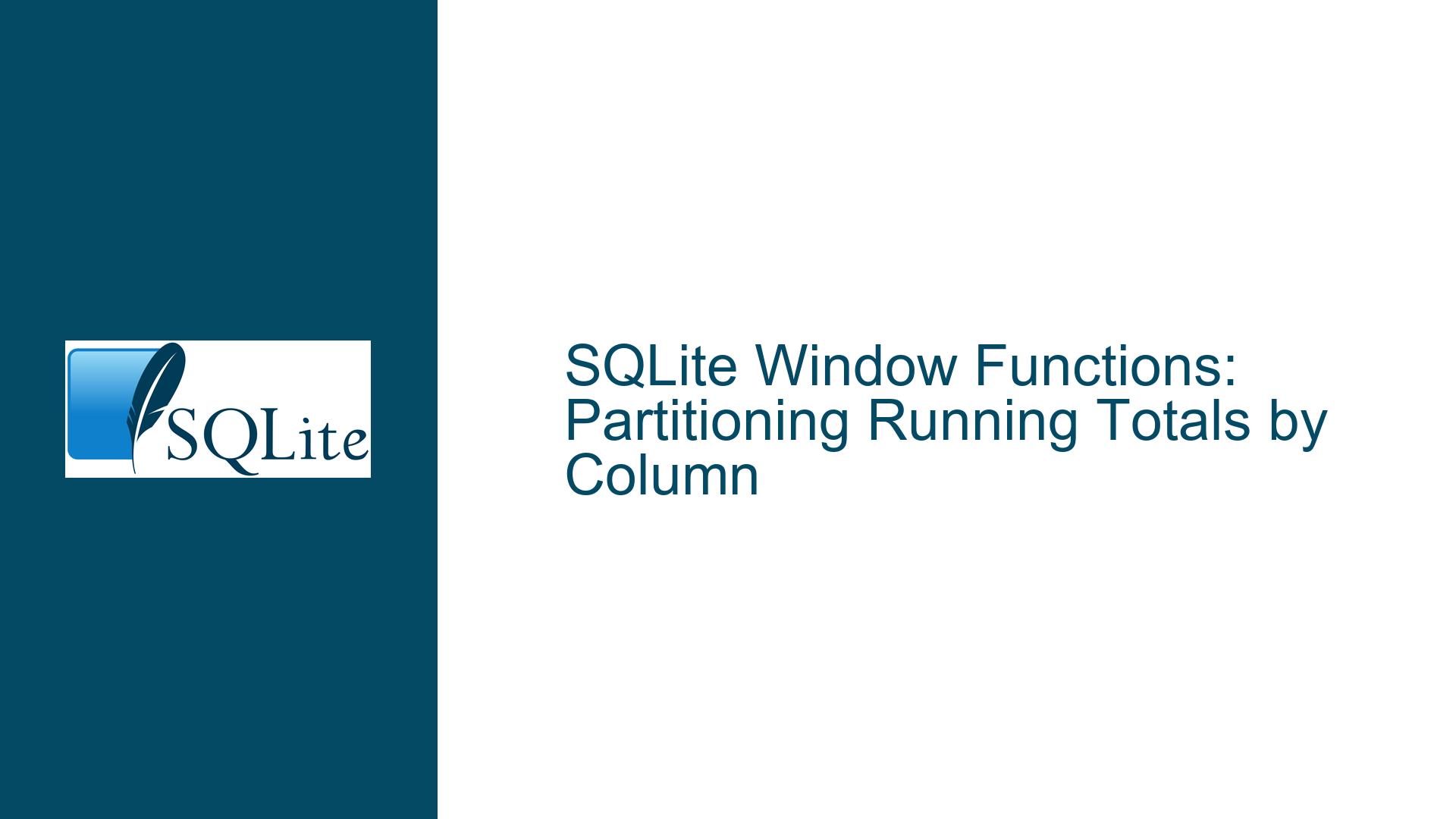SQLite Window Functions: Partitioning Running Totals by Column
Running Totals Incorrectly Aggregated Across All Rows
When working with SQLite, one common task is calculating running totals within a dataset. Running totals are cumulative sums that update as you progress through the rows of a result set. However, a frequent issue arises when the running total is calculated across all rows instead of being segmented by a specific column, such as accit in the provided scenario. This results in the running total continuing from the previous group rather than resetting for each new group.
In the example provided, the user attempted to calculate a running total for the difference between qtyd and qtyr columns, but the running total continued across all rows instead of resetting for each unique accit. This behavior is problematic when the dataset contains multiple groups, and the running total needs to be calculated independently for each group.
The SQL query initially used a window function with an ORDER BY clause but lacked the necessary PARTITION BY clause to segment the data by accit. This oversight caused the running total to aggregate across all rows, leading to incorrect results. For instance, the running total for the second group of accit values started from the cumulative sum of the previous group, rather than resetting to zero or the initial value of the new group.
Missing PARTITION BY Clause in Window Function
The root cause of the issue lies in the absence of the PARTITION BY clause in the window function. Window functions in SQLite, such as SUM(), ROW_NUMBER(), and RANK(), allow for advanced calculations over a set of table rows related to the current row. These functions are typically used with an OVER clause, which defines the window of rows to be included in the calculation.
The OVER clause can include three main components: PARTITION BY, ORDER BY, and ROWS or RANGE specifications. The PARTITION BY clause divides the result set into partitions or groups based on the specified column(s). The ORDER BY clause determines the order of rows within each partition, and the ROWS or RANGE specification defines the subset of rows within the partition to include in the calculation.
In the provided example, the user used the ORDER BY clause within the OVER clause but omitted the PARTITION BY clause. This caused the window function to treat the entire result set as a single partition, leading to a running total that aggregated across all rows instead of resetting for each unique accit.
The PARTITION BY clause is essential when calculating running totals or other cumulative metrics for distinct groups within a dataset. Without it, the window function cannot distinguish between different groups, resulting in incorrect aggregations. For instance, if the dataset contains multiple accit values, the running total should reset for each new accit group. However, without the PARTITION BY clause, the running total continues from the previous group, leading to inaccurate results.
Correcting the Query with PARTITION BY and Testing Results
To resolve the issue, the user needed to modify the query to include the PARTITION BY clause within the OVER clause. The corrected query should partition the result set by the accit column, ensuring that the running total resets for each new accit group. The modified query would look like this:
SELECT
accit,
qtyd,
qtyr,
SUM(qtyd - qtyr) OVER (PARTITION BY accit ORDER BY accit ROWS UNBOUNDED PRECEDING) AS RUNtotal
FROM
your_table;
In this query, the PARTITION BY accit clause ensures that the running total is calculated independently for each unique accit value. The ORDER BY accit clause specifies the order of rows within each partition, and the ROWS UNBOUNDED PRECEDING clause includes all rows from the start of the partition up to the current row in the calculation.
After implementing the PARTITION BY clause, the running total should reset for each new accit group, producing the correct results. For example, if the dataset contains the following rows:
| accit | qtyd | qtyr |
|---|---|---|
| 1 | 5 | 2 |
| 1 | 2 | 1 |
| 2 | 5 | 1 |
The corrected query would produce the following running totals:
| accit | qtyd | qtyr | RUNtotal |
|---|---|---|---|
| 1 | 5 | 2 | 3 |
| 1 | 2 | 1 | 4 |
| 2 | 5 | 1 | 4 |
In this example, the running total resets for accit 2, starting from the difference between qtyd and qtyr for that group. This ensures that the running total is calculated correctly for each accit group.
To further validate the results, it is recommended to test the query with a larger dataset containing multiple accit groups. This will help confirm that the running total resets correctly for each group and that the query performs efficiently, even with a large number of rows.
Additionally, it is important to consider the performance implications of using window functions, especially with large datasets. Window functions can be resource-intensive, as they require sorting and partitioning the data. To optimize performance, ensure that the table is properly indexed on the columns used in the PARTITION BY and ORDER BY clauses. For example, creating an index on the accit column can significantly improve the performance of the query.
In summary, the key to resolving the issue of incorrectly aggregated running totals in SQLite lies in the proper use of the PARTITION BY clause within window functions. By partitioning the result set by the appropriate column, such as accit, the running total can be calculated independently for each group, ensuring accurate and meaningful results. Testing the query with a variety of datasets and optimizing performance through indexing will further enhance the reliability and efficiency of the solution.






